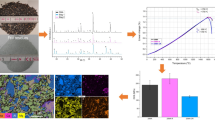Abstract
Continuous focus on capacity growth and increase in productivity by the manufacturing sector has led to the generation of a huge quantity of solid waste as by-product and depletion of the natural resources including refractories. The present study focuses on a sustainable approach to develop a low-cost castable intended for low-temperature applications by utilizing steelmaking slags as the raw materials. Firstly, the ladle slag generated after the secondary steelmaking process was used in the range of 50–70% as a complete source of CaO to develop a calcium-aluminate cement. The slag was used as a 100% replacement of limestone and partial replacement of Al2O3 source in the cement. Thus, it was possible to eliminate the CO2 emission associated with dissociation of limestone during the clinker making process. The castable was prepared using primary steelmaking slag as the aggregate and developed slag cement as the binder. CA and CA2 were formed as the primary phases in the slag cement, with Gehlenite, C12A7, and ‘Q’ phases as the secondary phases. Slag cement with 60% slag content exhibited superior strength as compared to commercial calcium-aluminate cement of medium purity. Further, the 110 °C and 1000 °C crushing strengths were found to be better for slag cement-added castable than the commercial cement-added one. Thus, it was possible to develop a green castable by using by-products of the steelmaking process that would not only help in reducing the carbon footprint, but also reduce the manufacturing cost and address the environmental concerns.








Similar content being viewed by others
References
Sarkar S, Mazumder D (2015) Solid waste management in steel industry—challenges and opportunities. Int Sch Sci Res Innov 9(3):978–981
Indian Minerals Yearbook (2017) Part- II: metals & alloys, 56th edn, Slag-Iron and Steel. https://mitra.ibm.gov.in/Documents/IMYB/Vol.%20II%20REVIEWS%20ON%20METALS%20AND%20ALLOYS/03202018150040Slag_Iron_Steel_AR_2017.pdf
Wu S, Xue Y, Ye Q, Chen Y (2007) Utilization of steel slag as aggregates for stone mastic asphalt (SMA) mixtures. Build Environ 42:2580–2585
Maslehuddin M, Sharif AM, Shameem M, Ibrahim M, Barry MS (2003) Comparison of properties of steel slag and crushed limestone aggregate concretes. Constr Build Mater 17:105–112
Monshi A, Asgarani MK (1999) Producing Portland cement from iron and steel slags and limestone. Cem Concr Res 29:1373–1377
Altun IA, Yilmaz I (2002) Study on steel furnace slags with high MgO as additive in Portland cement. Cem Concr Res 32:1247–1249
Rai A, Prabakar J, Raju CB, Morchalle RK (2002) Metallurgical slag as a component in blended cement. Constr Build Mater 16:489–494
Obidiegwu EO, Bodude MA, Esezobor DE (2014) Suitability of steel slag as a refractory material. J Metall Eng 3(3):119–125
Motz H, Geiseler J (2000) Products of steel slags, an opportunity to save natural resources. In: Woolley GR, Goumans JJM, Wainwright PJ (eds) Waste materials in construction. Elsevier, Amsterdam, pp 207–220
Ferreira JMF, Torres PMC, Silva MS and Labrincha JA (2002) Recycling and waste treatment in mineral and metal processing: technical and economic aspects. In: Proceedings of the TMS Fall Meeting, Lulea, Sweden, vol 2, pp 389–392
Bharati S, Joshi H, Sah R, Kaza M (2016) Development of a conventional castable using steelmaking slags for low temperature applications. J Tech Assoc Refract Japan 36(4):233–238
Nilforoushan MR, Otroj S, Saerie MR (2005) Phase formations and their effects on properties of a refractory calcium aluminate cement. Proceedings of UNITECR’05, pp 142–147
Gartner EM, Young JF, Damidot DA, Jawed I (2002) Hydration of Portland cement. In: Bensted J, Barnes P (eds) Structure and performance of cements, 2nd edn. Spon Press, London, pp 57–113
Bensted J (2002) Calcium aluminate cements. In: Bensted J, Barnes P (eds) Structure and performance of cements, 2nd edn. Spon Press, London, pp 114–138
Kapralik I, Stevula L, Hanic F (1989) Hydration and hydraulic properties of the q phase in the system CaO-Al2O3-MgO-H2O referred to high alumina cements. Cem Concr Res 19(4):519–526
Kirca O, Yaman O, Tokyay M (2013) Compressive strength development of calcium aluminate cement-GGBFS blends. Cem Concr Compos 35(1):163–170
Podworny J, Wala T, Sawkow J (2007) Microstructural studies on the Q-phase in alumina cement clinker. Solid State Phenom 130:225–228
Martinovic S, Vlahovic M, Majstorovic J, Matovic B, Volkov-Husovic T (2012) Thermal and mechanical properties of high alumina low cement castable. Metall Mater Eng 18(1):53–65
Author information
Authors and Affiliations
Corresponding author
Additional information
The contributing editor for this article was João António Labrincha Batista.
Publisher's Note
Springer Nature remains neutral with regard to jurisdictional claims in published maps and institutional affiliations.
Rights and permissions
About this article
Cite this article
Bharati, S., Sah, R. & Sambandam, M. Green Castable Using Steelmaking Slags: A Sustainable Product for Refractory Applications. J. Sustain. Metall. 6, 113–120 (2020). https://doi.org/10.1007/s40831-019-00261-7
Published:
Issue Date:
DOI: https://doi.org/10.1007/s40831-019-00261-7




